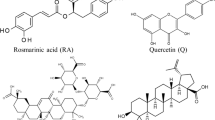Abstract
People all over the world are affected by the chronic, disabling autoimmune illness known as rheumatoid arthritis (RA). Herbal products are more commonly used in treating RA as of their safety and efficacy. The selected formulation for the present study is ANTARTH capsules, which is a polyherbal formulation containing different herbs effective in the treatment of RA. The purpose of this study was to develop and validate a precise, accurate, novel high-performance thin-layer chromatography (HPTLC) method for the simultaneous estimation of quercetin, berberine, rutin, and curcumin and to determine the levels in a polyherbal formulation. A good chromatographic separation was accomplished using a mobile phase consisting of toluene‒ethyl acetate‒methanol‒formic acid (5:3:2:0.5, V/V ) with wavelengths of 366 nm and 426 nm using an ultraviolet‒visible (UV‒VIS) detector. The retention factors for quercetin, berberine, rutin, and curcumin were found to be 0.57, 0.316, 0.093, and 0.663, respectively. A good linear regression relationship between peak areas and concentrations was obtained with correlation coefficients of 0.9988, 0.9987, 0.9977, and 0.9984 for quercetin, rutin, berberine, and curcumin, respectively. The method developed was found to be accurate, precise, and robust. The method was then applied in a marketed formulation (ANTARTH capsule), and the percent content was found to be 5.26 ± 1.09, 4.76 ± 0.83, 3.80 ± 0.94 and 7.62 ± 1.58 for quercetin, rutin, berberine, and curcumin, respectively.



Similar content being viewed by others
References
Wang Y, Chen S, Du K, Liang C, Wang S, Owusu Boadi E, Li J, Pang X, He J, Chang Y (2021) Traditional herbal medicine: therapeutic potential in rheumatoid arthritis. J Ethnopharmacol 279:114368. https://doi.org/10.1016/j.jep.2021.114368
Rathore B, Mahdi AA, Paul BN, Saxena PN, Das SK (2007) Indian herbal medicines: possible potent therapeutic agents for rheumatoid arthritis. J Clin Biochem Nutr 41:12–17. https://doi.org/10.3164/jcbn.2007002
García-Ramos JC, Galindo-Murillo R, Cortés-Guzmán F, Ruiz-Azuara L (2013) Metal-based drug-DNA interactions. J Mex Chem Soc 57:245–259. https://doi.org/10.29356/jmcs.v57i3.213
Lindler BN, Long KE, Nancy A, Taylor WL (2020) Use of herbal medications for treatment of osteoarthritis and rheumatoid arthritis. Medicines 7:1–18. https://doi.org/10.3390/medicines7110067
Nimesh S (2018) Herbal drug is better than allopathic drug in the treatment of rheumatoid arthritis. Int J Pharmacogn 5:539–545
Bhupinder K, Reena G, Gupta M (2017) Natural products in treatment of rheumatoid arthritis. Int J Green Pharm 11:S356–S363. https://doi.org/10.22159/ajpcr.2017.v10i11.20170
Ji JJ, Lin Y, Huang SS, Zhang HL, Diao YP, Li K (2013) Quercetin: a potential natural drug for adjuvant treatment of rheumatoid arthritis. Afr J Tradit Complement Altern Med AJTCAM 10:418–421
Laila O, Murtaza I, Abdin MZ, Ahmad S, Ganai NA, Jehangir M (2014) Development and validation of HPTLC method for simultaneous estimation of diosgenin and quercetin in fenugreek seeds (Trigonella foenum-graceum). ISRN Chromatogr 2014:1–8. https://doi.org/10.1155/2014/583047
Bidikar CM, Hurkadale PJ, Nandanwadkar SM, Hegde HV (2022) A validated spectro densitometric regulatory compliant USP-HP-TLC protocol for quantification of polyphenols and antioxidants from polyherbal formulations containing Terminalia species. J Chromatogr B 1207:123379. https://doi.org/10.1016/j.jchromb.2022.123379
Alam P, Parvez MK, Arbab AHA-DM (2017) Quantitative analysis of rutin, quercetin, naringenin, and gallic acid by validated RP- and NP-HPTLC methods for quality control of anti-HBV active extract of Guiera senegalensis. Pharm Biol 55:1317–1323. https://doi.org/10.1080/13880209.2017.1300175
Rodríguez-Valdovinos KY, Salgado-Garciglia R, Vázquez-Sánchez M, Álvarez-Bernal D, Oregel-Zamudio E, Ceja-Torres LF, Medina-Medrano JR (2021) Quantitative analysis of rutin by HPTLC and in vitro antioxidant and antibacterial activities of phenolic-rich extracts from Verbesina sphaerocephala. Plants 10:1–14. https://doi.org/10.3390/plants10030475
Kumar KA, Shetty SR, Narsu L (2011) HPTLC method development and validation for determination of rutin in flavanoidal fraction of Hibiscus micranthus Linn. E-J Chem 8:1444–1450. https://doi.org/10.1155/2011/902106
Ghosh VK, Nagore DH, Patil MJ, Prakash A (2010) Development and validation of a method for densitometric analysis of berberine in herbal extract and polyherbal formulation. Med Princ Pract 19:473–478. https://doi.org/10.1159/000320307
Rittiner JE, Moncalvo M, Chiba-Falek O, Kantor B (2020) Gene-editing technologies paired with viral vectors for translational research into neurodegenerative diseases. Front Mol Neurosci 13:1–22. https://doi.org/10.3389/fnmol.2020.00148
Sinden RR (2012) DNA structure and function. Academic Press, Cambridge. https://doi.org/10.1016/C2009-0-02451-9
Hewlings SJ, Kalman DS (2017) Curcumin: a review of its effects on human health. Foods 6:1–11. https://doi.org/10.3390/foods6100092
International Conference on Harmonization (2005) Q2 (R1): Validation of analytical procedures: text and methodology. Geneva. https://www.fda.gov/media/152208/download
Author information
Authors and Affiliations
Contributions
SL, RD, and SS contributed to the study’s conceptualization and design. AK handled the material preparation, data collecting, and analysis; she also drafted the text, which was then modified by all authors. All authors have read and approved the final manuscript.
Corresponding author
Ethics declarations
Conflict of interest
The authors have not disclosed any conflicts of interest that would have an impact on the information in this article.
Rights and permissions
Springer Nature or its licensor (e.g. a society or other partner) holds exclusive rights to this article under a publishing agreement with the author(s) or other rightsholder(s); author self-archiving of the accepted manuscript version of this article is solely governed by the terms of such publishing agreement and applicable law.
About this article
Cite this article
Khairnar, A., Lohidasan, S., Dubey, R. et al. Analytical method development and validation for the simultaneous estimation of quercetin, berberine, rutin and curcumin in a polyherbal formulation using high-performance thin-layer chromatography. JPC-J Planar Chromat 36, 63–70 (2023). https://doi.org/10.1007/s00764-023-00221-8
Received:
Accepted:
Published:
Issue Date:
DOI: https://doi.org/10.1007/s00764-023-00221-8



